Contents
What Is PCB Corrosion?
Corrosion is the oxidation process that occurs when oxygen reacts with metal, resulting in the formation of rust and the loss of the metal’s chemical characteristics.
A printed circuit board, or PCB, needs significant metal to interconnect components properly.
These PCB metal components are subject to corrosion in the same way as other corrosive metal objects.
Nevertheless, not every metal is equally susceptible to corrosion. Certain metals never corrode, while others seem to corrode relatively instantly.
Metals with exceptional corrosion resistance include Gold, graphite, and silver. Those prone to corrosion include plated tin, lead, copper, and plated nickel.
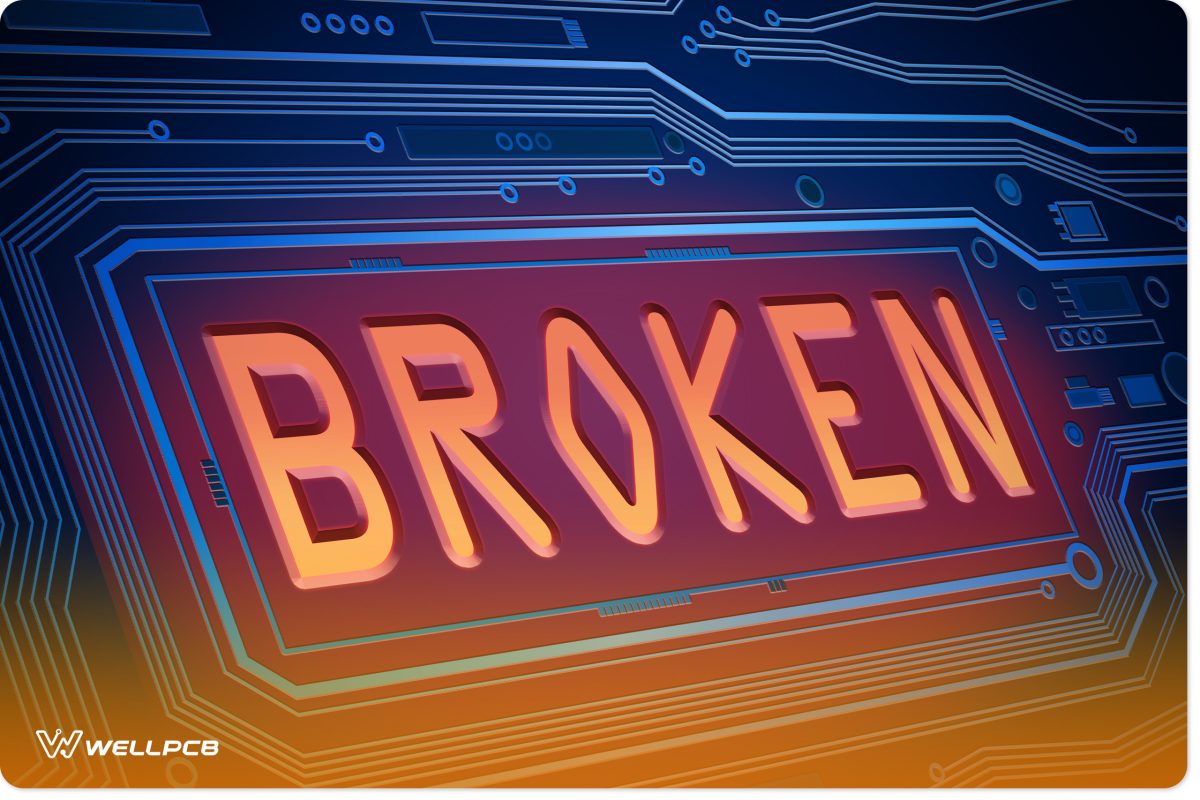
A Broken PCB
Types of Pcb Corrosion
Corrosion PCB comes in various forms, and knowing their characteristics helps diagnose and protect. The following are the different types of corrosion pcb:
Atmospheric Corrosion
Atmospheric corrosion pcb happens when metal comes into contact with water and reacts with oxygen molecules. When these two elements combine, they cause a reaction in which the metal ions join the oxygen molecules to make an oxide.
Atmospheric corrosion mostly affects copper metals. The metal(copper) will keep its mechanical characteristics even if it rusts, but it will lose its ability to conduct electricity.
Fretting Corrosion
Fretting occurs when solder-plated switches are repeatedly opened and closed. With repeated motion, the oxide layer on the surface is wiped away. While this happens by exposing the layer beneath the metal, the solder-plated switches result in fretting corrosion. Over time, the switch becomes dysfunctional due to the accumulated rust.
Inter-Granular Corrosion.
This kind of corrosion happens when chemical compounds fuse in the zone of a copper path. This occurs when field lines have much more corrosive contaminants.
Crevice Corrosion
Leftover material like the flux and other pollutants, such as cleaning solution, can accumulate in crevices beneath components and different types of hardware. Corrosion begins in the crevices of these materials when copper in this place reacts with these substances.
Galvanic Corrosion
Galvanic corrosion occurs when two different metals are present. It is also known as bimetallic corrosion. In the vicinity of an acerbic electrolyte, galvanic corrosion commonly occurs between the copper on the board’s surface and a metallic component, such as tin or gold plating.
An electrical current causes this type of corrosion. The nature of galvanic corrosion is comparable to pitting corrosion. However, the primary difference is that galvanic corrosion occurs when electrochemically different metals are in electrical contact with one another and the presence of an electrolyte.
Electrolytic Corrosion
Electrolytic corrosion occurs when two conductive traces touching each other develop dendrites. This expansion happens due to polluted ionic moisture entering the electrical voltage between both traces. The result is slivers of metal that can cause a short circuit.

A PCB Image
Pitting Corrosion
Localized galvanic corrosion is evident as cavities or holes in the surface of copper. It is responsible for degrading the conducting surface of circuit boards. The discontinuity process will eventually fail as the pit’s diameter and depth expand due to pitting corrosion.
Compounds that cause pitting corrosion also tend to obscure the damage they cause, making them harder to identify.
Electrolytic Dendrite Formation
Dendrites may develop on copper traces due to ionic pollution and moisture. If nearby copper traces have these dendrites, a circuit can short out and fail.
How to Clean a Corroded Circuit Board
You should clean the corroded parts without much hustle because you know about corrosion and how it occurs on circuit boards.
Protecting a corroded PCB from damage during the cleaning procedure would be best.
Thus, before looking at the various cleaning products, tools, and systems, ensure that the following precautions are taken into consideration:
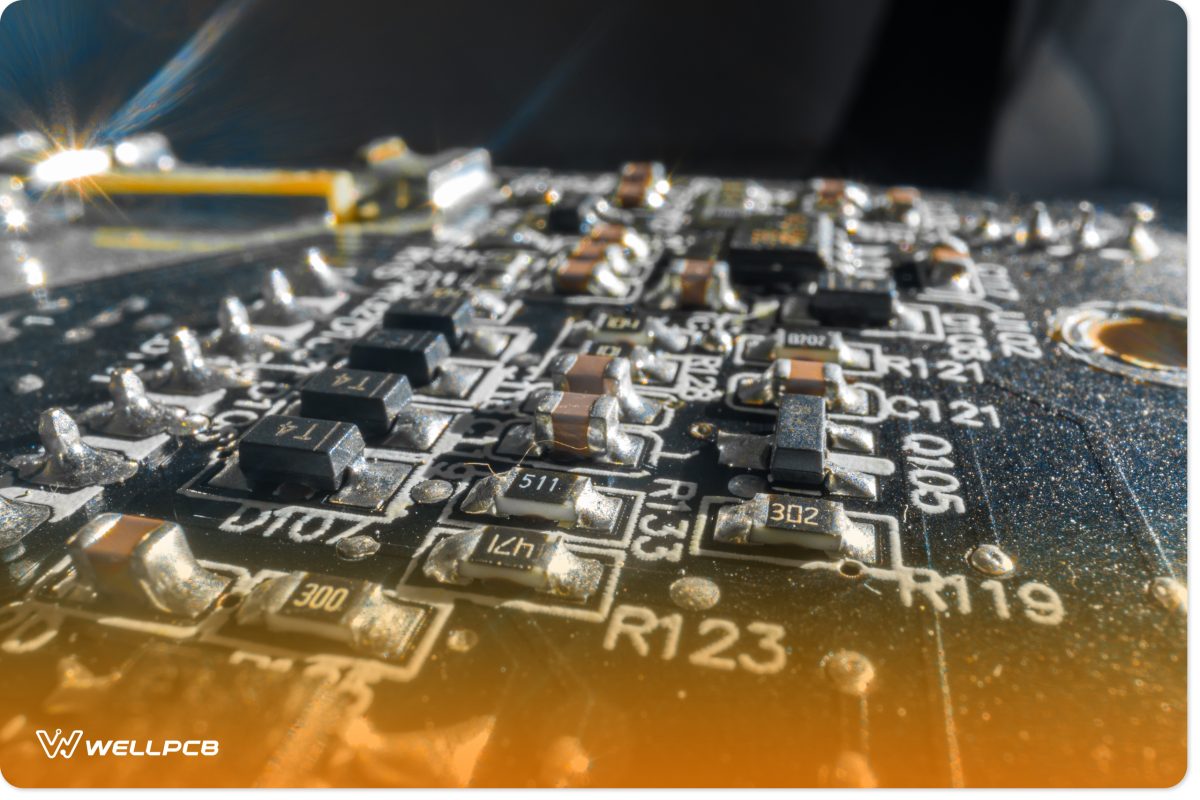
A Corroded Circuit Board
Security Measures for Cleaning Circuit Boards
- Before cleaning, disconnect all the sockets on the circuit board
- Take out all power sources, such as batteries and power adapters.
- Don’t use tap water, and keep your fingers dry.
- Wear gloves when you work with isopropyl alcohol to safeguard your hands.
- It takes time to clean, and trying to do it too quickly can cause more damage.
- Be cautious when cleaning.
Non-chemical and Chemical Substances For Cleaning The Corroded Boards
Corrosion is hard to remove, so you may need a few cleaning chemicals to get it off PCBs. This would include options such as those listed below:
- Isopropyl alcohol
Isopropyl alcohol, often known as rubbing alcohol, cleans dust, flux, debris, and rust from various parts. It should be your last resort for rust removal.
The process requires 90% alcohol, but higher percentages are desirable. It can only be used when compressed air, baking soda, or distilled water cannot fix the mess.
- Compressed Air
This method is one of the safest ways to clean PCBs because it removes rust and dust inside the electronic board by blowing them out with short bursts of spray. Since you are using slightly elevated air, you can eliminate any excess debris on your circuit board and keep it clean and free from rust.
- Distilled Water
Rather than using water from the tap to clean PCBs, it is better to use distilled water, which doesn’t harm any of the board’s parts.
- Baking Soda
Because it has sodium bicarbonate, baking soda works better even on the toughest dirt and disintegrates corrosion into tiny chunks. This makes cleaning all the rust and dirt off your circuit board easy.
PCB Corrosion Repair
How well you can clean and repair your circuit board depends significantly on the scale of damage and the effects corrosion has on it. After removing the corrosion, the boards may still have the damage caused by cleaning the rust out of them. So, it’s important to eliminate all the chemicals after cleaning to prevent further damage.
Wipe the PCB’s surface to remove these chemicals. When brushing the board’s surface, use a lint-free fabric immersed in isopropyl alcohol. If you don’t have isopropyl alcohol, you can use water or vinegar instead.
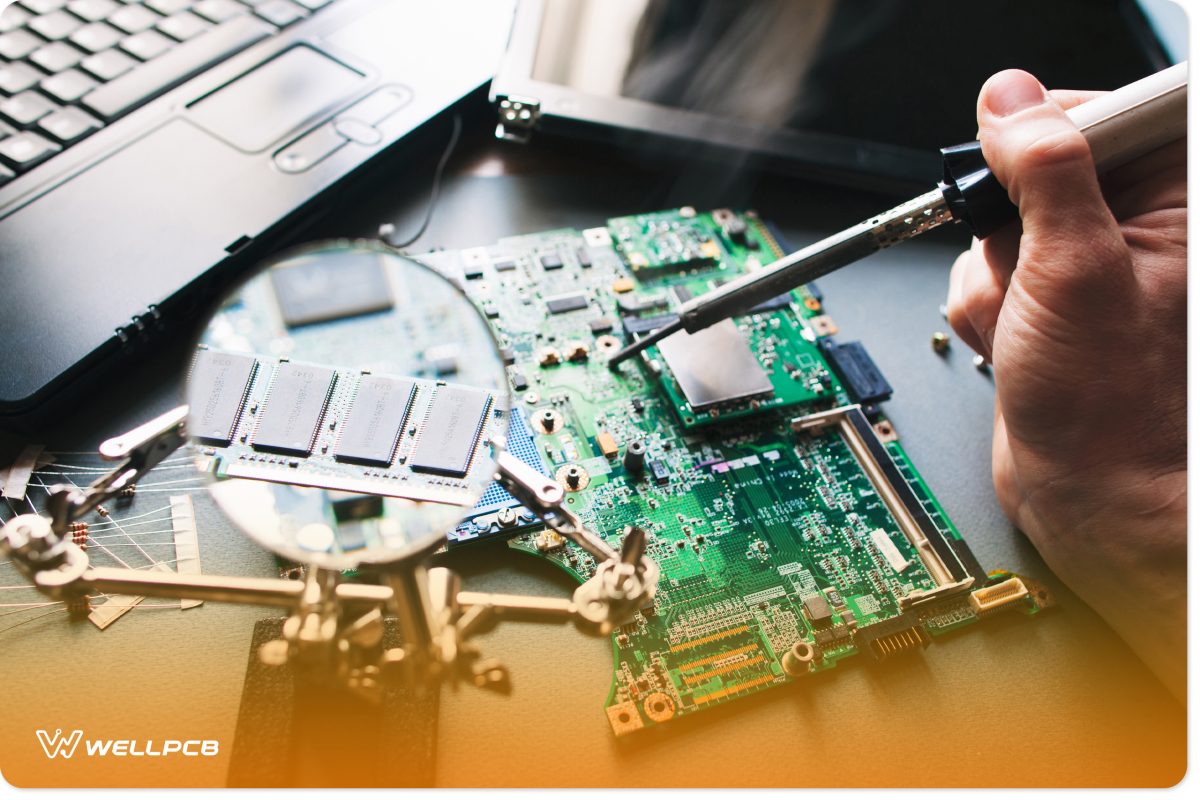
Repairing a PCB
What Causes PCB Corrosion?
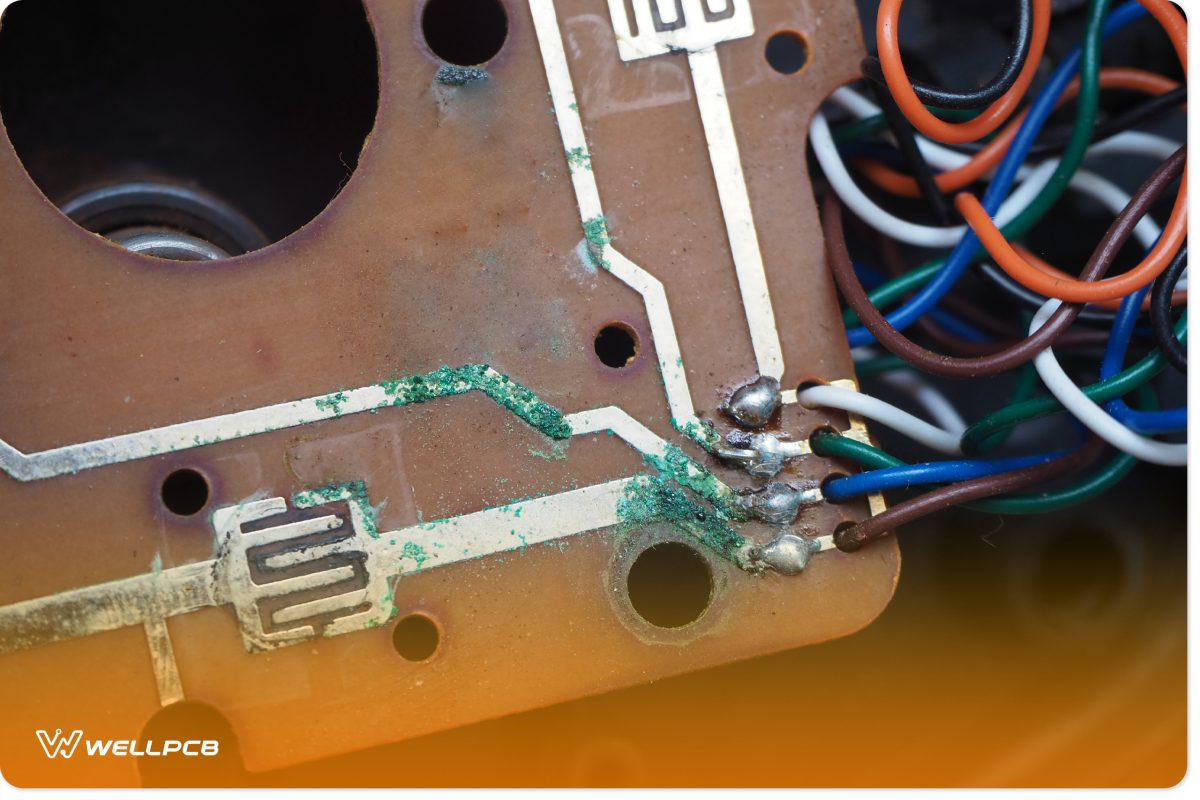
Copper oxide formation on corroded PCB
As discussed, specific types of corrosion have specific causes. Still, there might be some general causes of PCB corrosion. Taking preventative measures to minimize these causes will make your PCB last longer and operate more efficiently.
Contamination
Take, for example, electrolytic corrosion. The main culprit here is ionic contaminants between traces. When these two traces ultimately touch, corrosion causes metal slivers. This unchecked corrosion results in a short circuit of the whole board or a section of it.
Other environmental contaminants include water, dirt, and human contact.
Thermal Cycling
As much as thermal cycling is necessary in PCBs, it causes expansion and contraction. Eventually, the constant changes impact the solder joints, which crack. The problem isn’t the cracking. The influx of contaminants, such as moisture in the stress areas, leads to corrosion.
Humid Conditions and Moisture
Moisture is one of the main causes of PCB corrosion. Copper in the PCB reacts with moisture, leading to oxidation that damages the PCB. Atmospheric corrosion is the most common type of PCB corrosion.
Chemicals and Cleaning Processes
Cleaning PCBs requires gentle cleaning supplies such as baking soda, distilled water, household cleaners, and a soft, brittle brush. Household cleaners usually have phosphates that don’t damage the board.
However, using cleaners with harsh chemicals or brushes that can scratch the board will eventually corrode the PCB’s protective coatings.
Still, limit cleaning to only gentle procedures and chemicals. Overusing phosphate-heavy cleaning material can harm water sources, especially when cleaning at industrial levels.
Poor Quality Material
Manufacturers will opt for materials with high glass transition temperatures that can maintain their structure against intense heat changes.
Low-quality materials that crack quickly or develop fissures will corrode equally fast from moisture ingress.
How Do You Prevent PCB Corrosion?
Dealing with PCB corrosion after it occurs could damage the board even more. Therefore, it’s better to prevent corrosion from happening.
Keep The Board Away From Moisture
Keeping the PCB from moisture comes in two stages: during manufacturing and post-manufacture.
The manufacturing area must be dry and free from high humidity or uncontrolled moisture.
After, ensure the board stays dry. Otherwise, ionic corrosion will ruin the board.
Use High-Quality Material
Use materials that are less likely to expand and contract too much. High glass transition temperature substrates and ENIG and OSP finishes are the best picks for PCB fabrication.
They have better environmental protection and are less susceptible to temperature cracks and fissures.
Electroless Nickel Immersion Gold(ENIG) is key in curbing oxidative corrosion.
Use The Appropriate Coating
Copper is an essential part of PCB fabrication due to its electrical conductivity. However, it is highly susceptible to corrosion.
To prevent it from corrosion, find the right coating. Your options are epoxy, solder masks, aerosol spray, etc.
Protect The Entire Structure In Potentially Hazardous Environments
Most PCB applications will expose the entire unit to contaminants and corrosion. However, you can manage the chances of corrosion by protecting the unit.
Place protective casings around the PCB in saline, humid, or dusty environments.
Place A Dehumidifier Nearby
PCBs are in everyday household items. A dehumidifier in the home reduces air moisture to prevent PCB corrosion.
Corroded PCB Symptoms
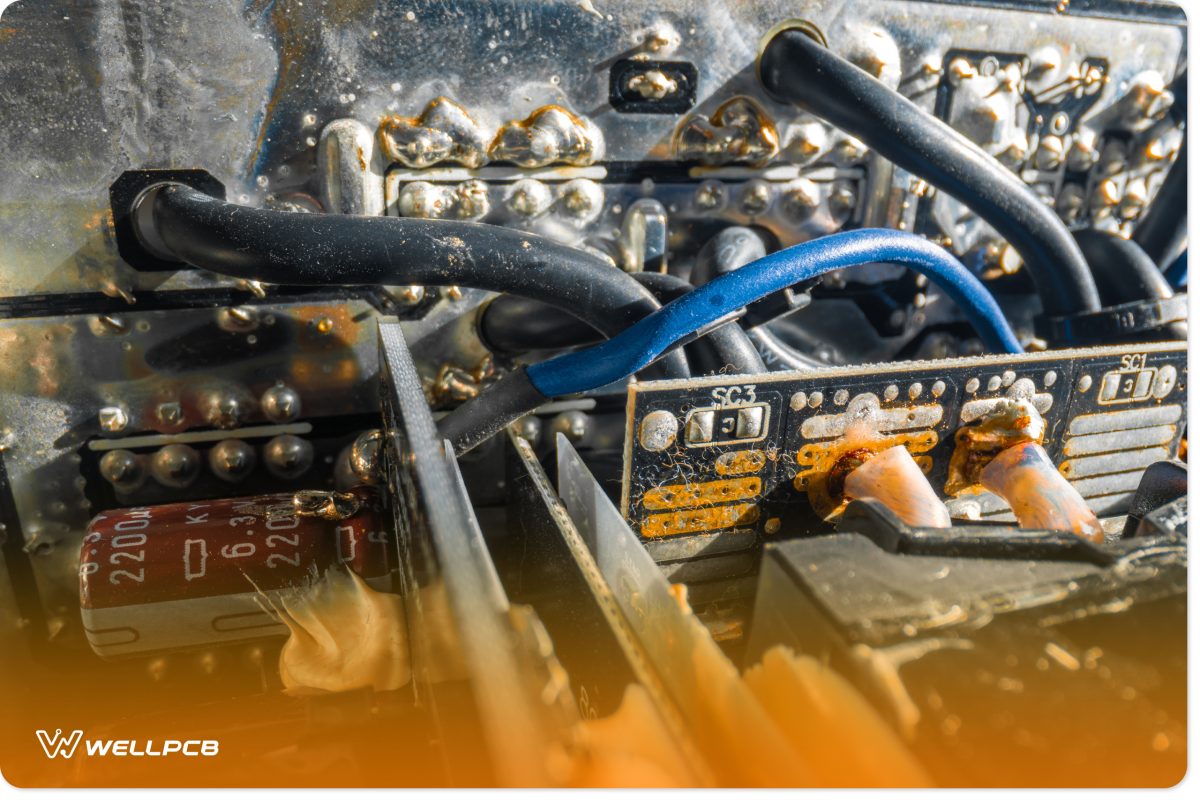
White discoloration in damaged PCB
Color Changes
Oxidation, a common symptom of PCB corrosion, is accompanied by color changes. Any color changes around copper platings or metals on the board are a symptom of corrosion.
Look for green, white, grey, or black discoloration to show signs of moisture corrosion or metal deterioration.
Metal Slivers
Loose metal slivers are signs that metal plating is chipping off. Also, they might indicate constant shape warping and board breakage.
Connection Inconsistencies
If the board conducts electricity on and off, it could be affected by corrosion that affects the copper and coated metals that conduct electricity on the board.
Overheating
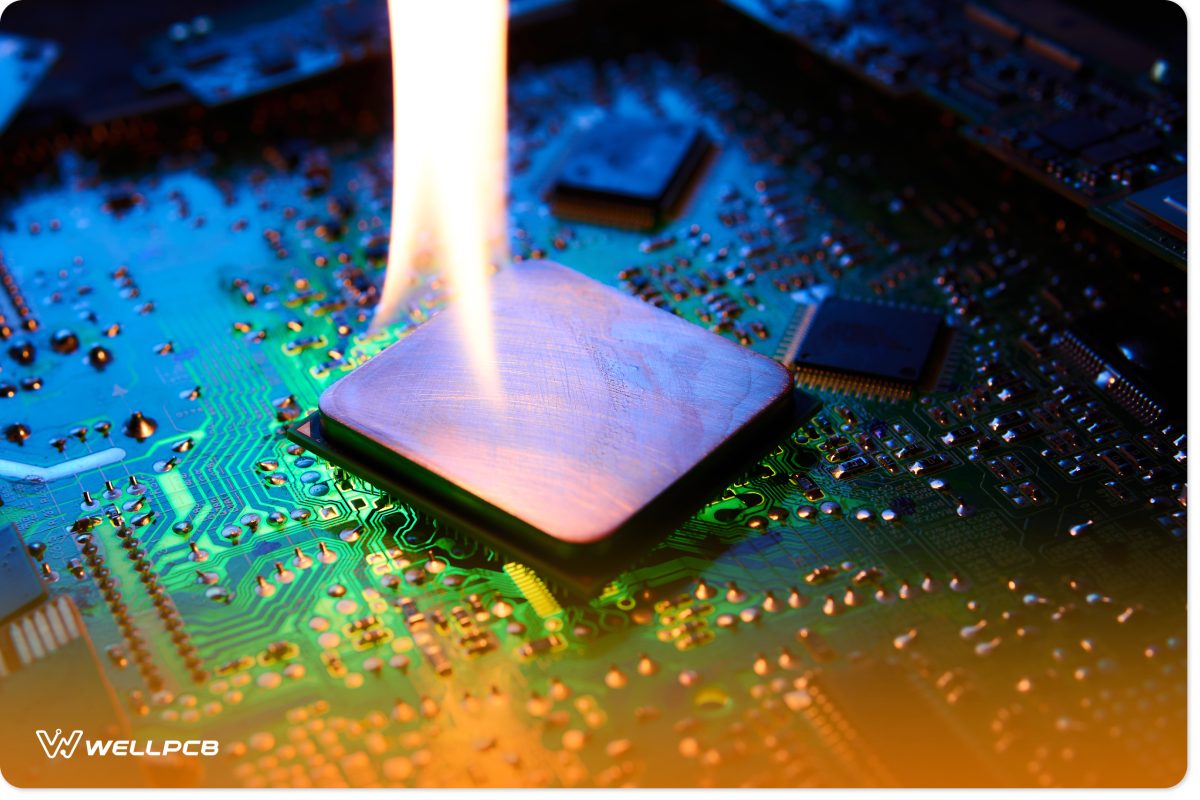
Heat on a PCB component
Corrosion affects all aspects of the board’s function. Elements that dissipate heat might also not work as they should. Therefore, you might notice unusual overheating when the unit is powered on.
FAQs:
What causes corrosion on the motherboard?
Motherboards are mostly affected by moisture, which causes corrosion.
Accidental spills, humidity buildup, or chemical exposure are likely to cause ionic contamination on the motherboard, which will corrode it over time.
The combination of oxygen and water on any metals on the motherboard creates an oxide that corrodes the board.
What does a damaged PCB look like?
If the PCB damage is permanent, you’ll likely see discolored spotting, cracks, or chips. Look around the traces for any green or white.
Summary
Corrosion pcb is a normal occurrence that will always happen at some point in your electronic gadgets’ life span.
Corrosion cannot be completely avoided, but it can be prevented and treated to extend the life of your devices.
Learning to remove corrosion from a circuit board is simple if you follow the tips discussed in this blog.





